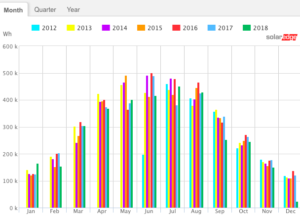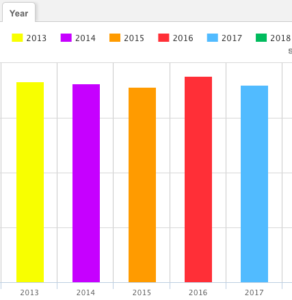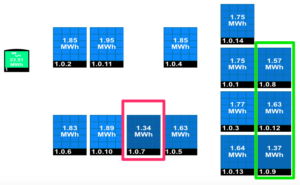How to know if your solar panels are working, or not

A favorite activity among people who go solar is watching their monitoring system to see just how much money they’re saving. Keeping tabs on your system is important and you should understand what constitutes normal variations in the energy output of your system. This way you can tell the difference between normal output and a problem with your system.

The amount of energy your system produces will change from hour to hour and day to day depending on season, weather, time of day among other factors. It’s important to have a baseline understanding of how your solar system’s output varies throughout the days, months, and years. See the graph and how variations happen across years for the same calendar month? That’s due to gradual decline in module efficiency (< 1%/year) and seasonal weather variations.
But averaged over the life of the system, annual production is roughly in the same range each year.
Rainy and cloudy days will have lower outputs than a clear day. Morning and evening hours may have lower outputs than mid-day (more direct sunlight) depending on your array’s orientation. Many installers provide system monitoring that you can check on your PC or phone. Most installers will provide a system level online monitoring system. Check this system regularly to familiarize yourself with your installation’s output variations and other features the monitoring system may have.
There are a few things you can do before calling your installer should you notice your system’s output of electricity drops dramatically.

First, do a visual check of system. Look for new sources of shade, like a tree that needs trimming. You should also check for dirty or cracked panels (dirty panels should self-clean with rainfall, we do not recommend going up on roof yourself). You should also check wiring for corrosion or damage from critters
Sometimes your solar system won’t start up if there isn’t enough sunlight to active the system. This would happen on a particularly stormy or rainy day.
In some situations, it will be normal for some panels to produce less than others if they are closer to shading obstructions. In the example below, the module in the red box is next to a vent pipe that partially shades it during certain times of the day. The modules in the green box are closest to a chimney that casts shade on them for part of the day, especially in the winter months when the sun is lower in the sky.

If your system uses micro-inverters or optimizers, it should come with a panel-level monitoring system. You can use this to track the individual output of each solar panel. This should tell you if a solar panel has cut out or stopped producing. If that is the case, you should contact your installer who will be able to run diagnostics on the system.
Although performance issues like the ones described above are rare, they do happen. Taking the simple steps we described are a good way to protect your investment in solar.
